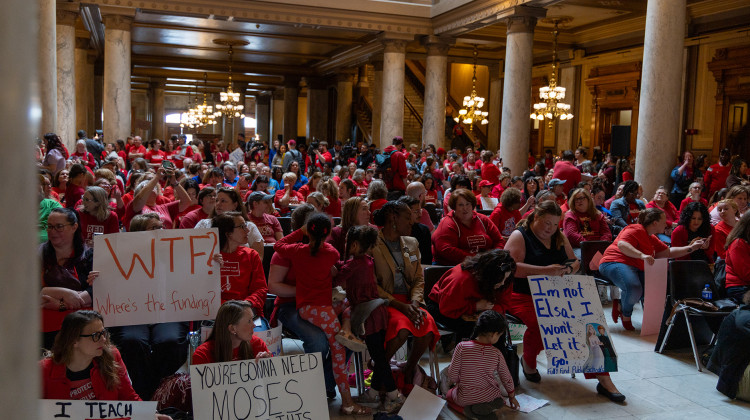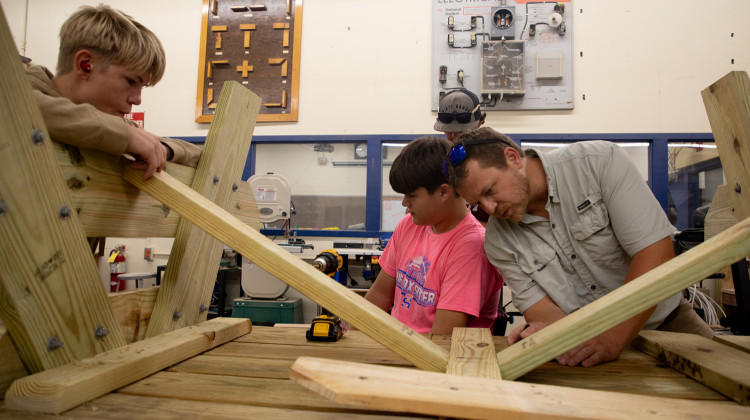
Some of Indiana's rural school districts plan to use federal pandemic aid to pay for infrastructure upgrades.
(Lauren Chapman/IPB News)Nearly $2.6 billion in federal coronavirus relief funds is headed to Indiana public schools. In rural districts where income from property taxes is low, some of that money will pay for long-delayed building maintenance.
In one school system, the superintendent hopes to replace flooring that’s more than three decades old. In another, leaders are considering building an addition to make space for social distancing. Many districts will overhaul heating, ventilation and air conditioning systems to improve air quality.
The temporary influx of funding, which districts have more than three years to spend, was part of aid packages Congress passed in December 2020 and March 2021. Known as ESSER II and III, federal guidance requires schools to use some of the funding to address learning loss. District leaders say the bulk of the money will likely be used to help students who missed out on instruction during the pandemic by paying for costs such as extra educators, new technology, and textbooks.
But schools are allowed to use the federal money for all kinds of expenses, including building upgrades that improve air quality or address environmental hazards, according to a spokeswoman from the Indiana Department of Education. The department will review spending plans for each district.
Indiana schools rely on property taxes to pay for building maintenance. But school leaders say that property tax caps, which were adopted more than a decade ago, make it hard for them to afford upkeep.
“We oftentimes will budget for a particular project, but then if a chiller or a boiler happens to go out, it takes precedence and then something has to be pushed further down on the list,” said Superintendent Dan Roach of the Washington Community Schools, a rural district in southwest Indiana.
Washington is in an especially tight spot because the district of 2,400 students has low property tax revenue. It gets about $2,000 per student in taxes, compared to the state average of about $3,000.
The unexpected federal money will allow Washington and other districts to pay for projects that have long been on their wishlists, Roach said.
Along with hiring more educators and buying technology, the district plans to replace flooring that is over 30 years old, repair or replace roofs, and upgrade a heating, ventilation and air conditioning system.
Indiana does not track the condition of school facilities, but national data shows that many school districts have buildings that need maintenance. For example, about 40% of districts nationwide need to update heating, ventilation and air conditioning systems in at least half their schools, according to a survey from the federal Government Accountability Office.
In Austin, a rural Indiana town outside of Louisville, the school district expects to spend about 20% of the $4.5 million it is expected to receive in federal aid on facilities, said Superintendent Trevor Jones. The district, also known as Scott County District 1, has limited property tax revenue in part because of tax caps.
Repairs include new air conditioning in the gym and replacing flooring. For students, it means cleaner buildings with better air quality, Jones said.
In South Adams schools, a rural district outside of Fort Wayne, Superintendent Michelle Clouser-Penrod is considering using some of the $11.2 million in federal funding to build an addition so that students are able to space out.
The district is getting more than $9,000 per student in federal money — one of the highest amounts in Indiana. The aid is based on the number of low-income families in a community, and South Adams has a large Amish population, Clouser-Penrod said.
All 1,200 students are housed in a single building and share a cafeteria, which became a challenge during the pandemic, Clouser-Penrod said.
She would like to make clases smaller, but “we don't have any place to put new teachers,” Clouser-Penrod said. “Social distance wise, we had nowhere near enough space.”
CORRECTION (May 20, 2021): An earlier version of this article misstated the property tax revenue in Washington Community Schools and the state average. Washington Community Schools gets about $2,000 per student in property taxes. The state average is about $3,000.
Contact WFYI education reporter Dylan Peers McCoy at dmccoy@wfyi.org. Follow on Twitter: @dylanpmccoy.
 DONATE
DONATE






 Support WFYI. We can't do it without you.
Support WFYI. We can't do it without you.